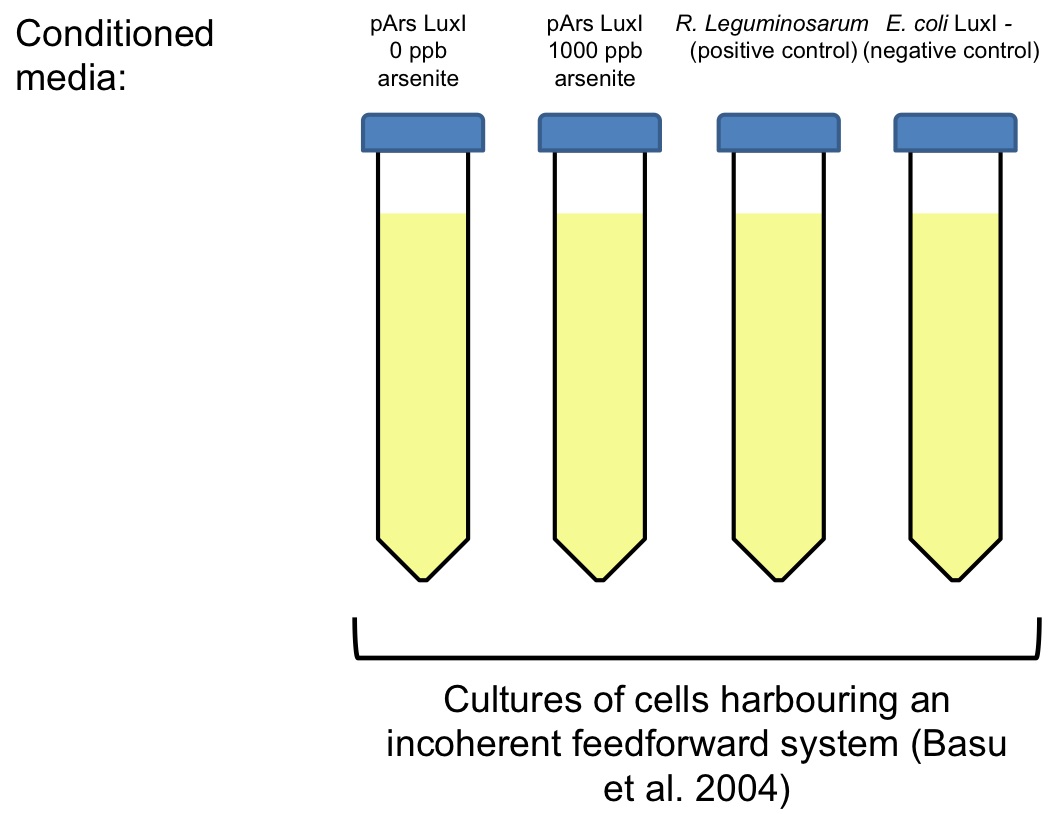Team:Buenos Aires/ res rgfp
From 2013.igem.org
(→Quantitative measure of HSL production by pArs LuxI construction (Bba_K1106008)) |
(→Quantitative measure of HSL production by pArs LuxI construction (Bba_K1106008)) |
||
| Line 48: | Line 48: | ||
arsenite. | arsenite. | ||
| - | [[File:Basu_diseño.jpg | + | [[File:Basu_diseño.jpg|600px|]] |
Next day, E. coli culture carrying the incoherent feedforward plasmids was split in three tubes and | Next day, E. coli culture carrying the incoherent feedforward plasmids was split in three tubes and | ||
Revision as of 13:00, 24 September 2013
AHL production tested with Chromobacterium violaceum
Chromobacterium violaceum is a bacteria that in presence of certains AHLs turns violet due to the production of violacein.
Materials: Top Agar petri dishes with two layers (agar 0,5% and regular agar 1.5%) Chromobacterium violaceum TY medium LB medium Rhizobium leguminosarum as a positive control E. coli DH5α harbouring our construct pArs_LuxI
In order to assess whether the LuxI generator under arsenic promoter synthesizes AHL (a quorum sensing molecule) when induced with arsenite, a top agar petri dish was prepared. A layer of sterile LB-agar 1,5% was poured and on top of it an additional layer of LB-agar 0,5% mixed with a Chromobacterium v. Wells of a volume around 50 ul were performed on the top layer to inoculate different cultures into them.
Four different cultures were grown overnight:
· A Rhizobium leguminosarum culture, grown at 30 ºC in TY medium, as a positive control. · Two E. coli cultures (DH5alpha) harbouring the LuxI enzyme gene of Vibrio fischeri, under the control of an arsenite inducible promoter. One of them was added with 1000 ppb of arsenite. · An E. coli culture without the codifying sequence of LuxI, as a negative control.
The petri dish, with Chromobacterium v. on the top layer, was inoculated into the wells with samples of 60 ul of each culture and grown overnight at 30ºC. As Chromobacterium v. is a lactone sensitive bacteria, this method allows to detect AHL presence in a easy and very intuitive way by observing the formation of a violet halo around the inoculation wells which results positive.
Next, the results obtained:
· Inoculated wells from Rhizobium legumonosarum -the positive control- and the one from our construct with coding sequence of LuxI that was previously induced with 1000 ppb of arsenite were positive to the presence of AHL, as it’s shown on the photo as a violet halo around the wells. · The negative control without a coding sequence of LuxI and the culture from our construct LuxI without added arsenite didn’t show any halo, as it was expected.
Quantitative measure of HSL production by pArs LuxI construction (Bba_K1106008)
Protocol
four different cultures were grown overnight:
• An E. coli culture carrying two plasmids that encode an incoherent feedforward system,
designed by Basu et al. (Basu et al 2004), which is inducible by Vibrio fischeri’s Lux system.
This plasmids were gently provided by Ron Weiss’ lab.
• A Rhizobium leguminosarum culture, grown at 30 ºC in TY medium, as a positive control.
• Two E. coli cultures (DH5alpha) harbouring the LuxI enzyme gene of Vibrio fischeri, under the
control of an arsenite inducible promoter (pArs). One of them was added with 1000 ppb of
arsenite.
Next day, E. coli culture carrying the incoherent feedforward plasmids was split in three tubes and
centrifuged. The cells were kept the cells, and the supernatant was discarded. Besides, the other
three cultures were centrifuged. The supernatant was kept and the cells were discarded. This
four conditioned media were used to resuspend the cells carrying Basu’s incoherent feedforward
plasmids.
Cells were incubated at 37 ºC and every 15 minutes we took an aliquot of each culture, until 105
minutes after the beginning of the induction.
Afterwards, we measured GFP production at each condition through time.
Results
Positive control
We observe a high induction of GFP synthesis in cells carrying Basu’s plasmids cultured in medium conditioned by Rhizobium leguminosarum, consistently with what has expected. Despite, probably because the experiment was stopped at an early time, the fall of GFP signal predicted by the model of Basu et al. 2004 in this condition could not be observed.
E. coli harbouring pArs_LuxI conditioned media
Cells cultured in medium conditioned by E. coli pArs_LuxI with 1000 ppb arsenite expressed GFP in a fashion similar to that described by Basu et al. 2004, showing a peak of production around 50 minutes after induction. On the other side, cells cultured in medium conditioned by E. coli pArs_LuxI with 0 ppb arsenite showed a smaller induction and delayed in time, probably due to leaky transcription of the repressed arsenite promoter.
 "
"

